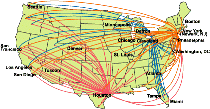United States Department of Transportation

United States Department of Transportation: Publications
Date of this Version
2004
Abstract
The natural gas pipeline industry routinely checks their pipeline right-of-ways to ensure that leaks are detected. Pipeline companies use various processes to detect signs of leaking pipes, including using vehicles or low-flying aircraft. The leak detection methods range from directly sensing the gas to looking for indirect signs of leakage. The U.S. Department of Energy (DOE) and the U.S. Department of Transportation’s Office of Pipeline Safety (OPS) have provided funding to several commercial companies and research laboratories to develop advanced remote sensor systems to provide high quality, cost-effective leak detection information. To aid in the development and availability of these remote detection systems, the DOE funded a project to conduct field testing of five remote sensor leak detection systems. OPS provided co-funding for this project.
The five systems chosen to be included in the field test were being developed by En’Urga Inc., ITT Industries, Inc., LaSen, Inc., Lawrence Livermore National Laboratories, and Physical Sciences Inc. The technologies included passive infrared multi-spectral scanning, laser-based differential absorption LIDAR (Light Detection and Ranging), hyperspectral imaging, and tunable diode laser absorption spectroscopy. The sensor systems were mounted in an unmodified automobile, a helicopter, or a fixed-wing aircraft.
A “virtual pipeline,” that simulated conditions of an actual pipeline was created at the Rocky Mountain Oilfield Testing Center field site at NPR-3, north of Casper, Wyoming. The pipeline route was approximately 7.5 miles long and was marked by 14 direction change markers and 22 sets of road crossing markers. Fifteen leak sites, which included three types of gas releases, were established along the route, with natural gas leak rates ranging from 1 scfh to 5,000 scfh. One leak site was designated as a “calibration” site, and the location and leak rate for this site were provided to the equipment providers. Leak sites that were designed to cause plant stress were on continuously from August 30, 2004 through September 17, 2004. The remaining leak sites were set daily during the test week of September 13 to 17, 2004.
Four equipment providers were scheduled to collect data along the pipeline path twice each test day. One equipment provider, at their request, was scheduled to collect data once each day for one of their platforms and twice during the entire week for their other platform. Reports of the findings for the individual equipment providers were due to Southwest Research Institute® (SwRI®) within two weeks after the testing period and are included in this report as Appendix I. Based on the data provided, leaks at many of the leak sites were successfully detected. Leak rates of 500 scfh or higher were detected at least 50% of the time. Leak rates of 100 scfh were only detected 15% of the time. Leak rates of 15 scfh and 10 scfh were only detected about 5% of the time. The 1-scfh leak was never detected. There were also a large number of “false positive” leak sites identified by the equipment providers.
Some of the equipment providers made system improvements during the week including repairing malfunctioning equipment, mechanical modifications to improve performance in field applications, and developing improved data handling schemes. Other modifications have been defined for future work by some of the equipment providers.
Improvements for potential future testing efforts have been identified and include improving the pipeline route and adding more leak sites.


Comments
Published in SwRI® Project No. 18.10485 (2004) 262 p.